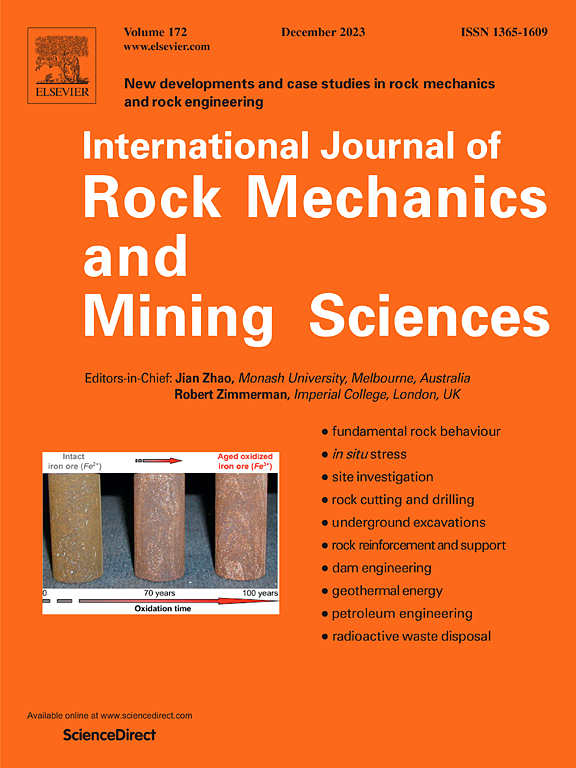超声波在含湿岩石中的传播:吸湿对速度变化和衰减的影响
IF 7.5
1区 工程技术
Q1 ENGINEERING, GEOLOGICAL
International Journal of Rock Mechanics and Mining Sciences
Pub Date : 2025-06-24
DOI:10.1016/j.ijrmms.2025.106188
引用次数: 0
摘要
本研究的重点是研究水分对三种岩石的力学退化的影响。通过动态吸湿实验了解不同相对湿度条件下的水蒸气吸附特性。在不同相对湿度水平下进行的超声波测试揭示了波速和衰减对含水量变化的敏感性。随后的无侧限抗压强度(UCS)测量证明了水分引起的降解如何影响岩石的力学特性。本研究评估了RH对三种岩石超声纵波/纵波速度的影响,揭示了湿度对波速变化的明显影响。灰色页岩和砂岩表现出相似的纵波行为,而黑色页岩表现出明显不同,在较低相对湿度下表现出早期硬化效应。孔隙尺度上的饱和非均质性和大尺度上的斑块效应突出了岩石、水分和波浪特征之间复杂的相互作用。此外,研究还评估了相对湿度对部分饱和岩石中超声波衰减的影响。受动态含水饱和度和织物非均质性的影响,p波衰减随相对湿度的增大而增大。s波衰减也表现出类似的趋势,不同岩石类型之间存在明显的差异。单轴抗压试验表明,较高的含水率导致不同岩石试样的单轴抗压值降低。加载过程中纵波速度和横波速度进一步强调了水分敏感性,其中横波速度对含水率变化的响应更大。动态杨氏模量在UCS测量期间表现出明显的变化,突出了水分含量对机械降解的影响。这些发现强调了在理解和预测岩石力学行为时考虑水分影响的重要性。本文章由计算机程序翻译,如有差异,请以英文原文为准。
Transmission of ultrasonic wave across moisture rocks: Effects of moisture sorption on velocity variation and attenuation
This study focused on investigating the impact of moisture-induced mechanical degradation on three types of rocks. Dynamic moisture sorption experiments were conducted to understand water vapor sorption across different relative humidity (RH) conditions. Ultrasonic tests, performed at various RH levels, revealed the sensitivity of wave velocities and attenuations to changes in moisture content. Subsequent measurements of unconfined compressive strength (UCS) demonstrated how moisture-induced degradation affects the mechanical properties of rocks. This study evaluated the effects of RH on ultrasonic P-/S-wave velocities in three rocks, revealing distinct moisture effects on wave velocity variations. Gray shale and sandstone exhibited similar P-wave behaviors, while black shale differed significantly, showcasing early stiffening effects at lower RH. Saturation heterogeneities at the pore-scale and patchy effects at the large scale highlighted complex interactions between rock, moisture, and wave characteristics. Furthermore, the research assessed the impact of relative humidity on ultrasonic wave attenuations in partially saturated rocks. As RH increased, P-wave attenuation generally rose, influenced by dynamic water saturation and fabric heterogeneity. S-wave attenuation exhibited a similar trend, with noticeable variations among rock types. UCS tests indicated that higher moisture content led to decreased UCS values across various rock specimens. The P- and S-wave velocities during loading further emphasized moisture sensitivity, with S-wave velocity being more responsive to moisture content variations. Dynamic Young's moduli exhibited distinct changes during UCS measurements, highlighting the influence of moisture content on mechanical degradations. These findings underscore the importance of considering moisture effects in understanding and predicting the mechanical behavior of rocks.
求助全文
通过发布文献求助,成功后即可免费获取论文全文。
去求助
来源期刊
CiteScore
14.00
自引率
5.60%
发文量
196
审稿时长
18 weeks
期刊介绍:
The International Journal of Rock Mechanics and Mining Sciences focuses on original research, new developments, site measurements, and case studies within the fields of rock mechanics and rock engineering. Serving as an international platform, it showcases high-quality papers addressing rock mechanics and the application of its principles and techniques in mining and civil engineering projects situated on or within rock masses. These projects encompass a wide range, including slopes, open-pit mines, quarries, shafts, tunnels, caverns, underground mines, metro systems, dams, hydro-electric stations, geothermal energy, petroleum engineering, and radioactive waste disposal. The journal welcomes submissions on various topics, with particular interest in theoretical advancements, analytical and numerical methods, rock testing, site investigation, and case studies.

 求助内容:
求助内容: 应助结果提醒方式:
应助结果提醒方式:


